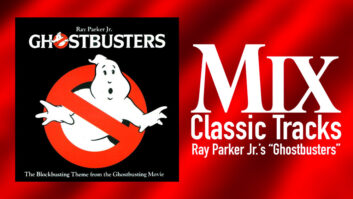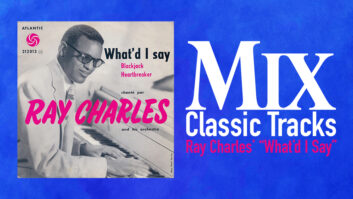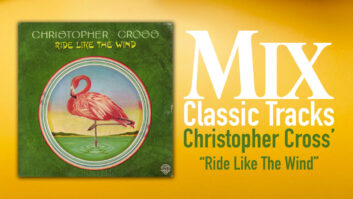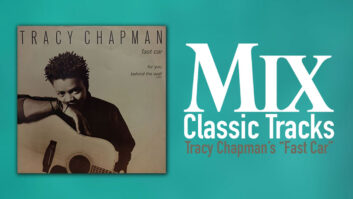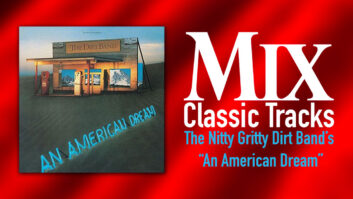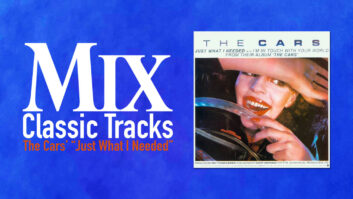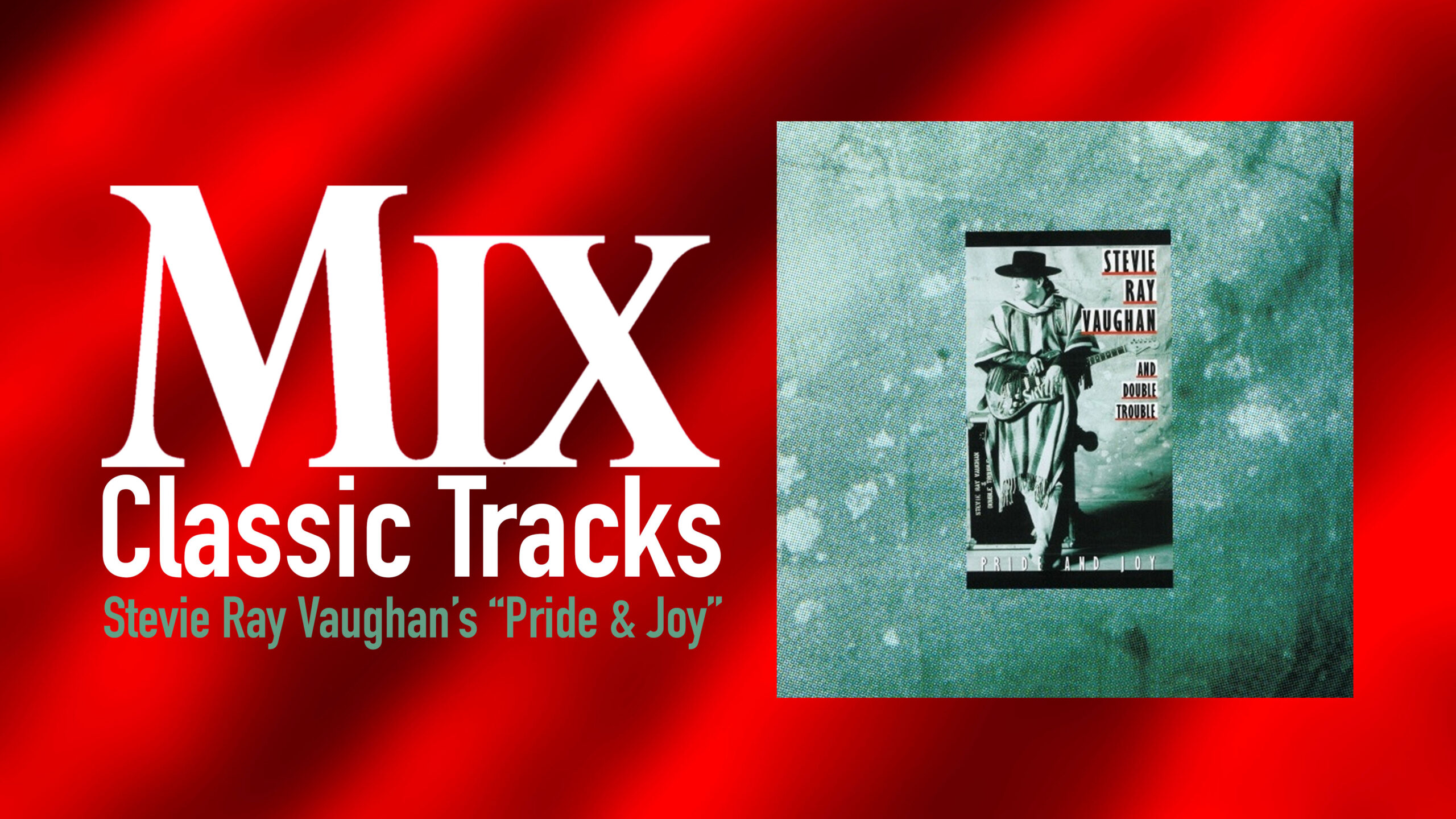
The story of the recording of this month’s Classic Track begins in Switzerland at the Montreux Jazz Festival in July 1982. Mick Jagger and Keith Richards had been wowed by the phenomenal blues/rock/R&B guitarist Stevie Ray Vaughan at a club gig in Dallas on an off-night during the Stones’ fall 1981 tour, and subsequently had him and his rhythm section—bassist Tommy Shannon and drummer Chris Layton, known as Double Trouble (after an old Otis Rush song)—play a private party in New York City. The Stones’ enthusiasm for Stevie Ray helped to influence producer Jerry Wexler—who had independently been knocked out by the guitarist at a club in Austin—to urge the organizers of the Montreux Festival to book the Texas sensation, even though they had never hired an unsigned band before.
Though Stevie Ray didn’t have a record deal, he wasn’t exactly a newcomer to the scene. He was 28 when he played Montreux that first time and was already something of a legend in the Southwest. He started playing when he was seven, influenced heavily by his talented older brother, Jimmie (best known as the leader of the Fabulous Thunderbirds), and was in a succession of bands through his teens and early 20s. On his way to developing his own style, he learned from a slew of amazing guitarists, including the first great Texas electric axe slinger, T-Bone Walker; blues immortals including the Three Kings—B.B., Albert and Freddie—Buddy Guy and Hubert Sumlin; the always underrated picker Lonnie Mack; Django Reinhardt, Wes Montgomery; and, perhaps most importantly, Jimi Hendrix, whose sound and spirit infused so much of Stevie Ray’s music.
Back to Montreux ’82. Stevie Ray and Double Trouble slayed the crowd, and also attracted the attention of two notable musicians in the audience. David Bowie asked Vaughan to play on the album he was working on at the time—Let’s Dance, which became Bowie’s best-selling disc ever—and invited him to play lead guitar in his touring band. (Vaughan appears on many songs on the album, but declined the tour offer.) Jackson Browne was also at the festival and was so impressed by Vaughan that he offered him free studio time at his personal Down Town studio in L.A.
Four months after Montreux, Stevie Ray’s manager, Chesley Millikin, accepted Browne’s offer, and right after Thanksgiving flew the band from Austin to L.A. in the hopes of cutting a demo that would get the act signed to a major label and perhaps also be the foundation for a proper album. For a while, Vaughan had been talking about recording with Austin engineer and musician Richard Mullen, whom he’d known for several years (and who had been in Montreux as the band’s main engineer), “but Chesley wasn’t going to fly me out to California, and they’d already set up these sessions with Jackson Browne’s engineer,” Mullen says from his Austin home.
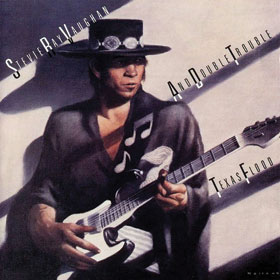 As fate would have it, however, Mullen was in L.A. finishing up a record with Christopher Cross when Vaughan and company arrived, and Stevie Ray invited him to come over to the studio, where the group was doing some preliminary work. The band apparently wasn’t entirely happy with the engineer they had been provided with, and after some discussion, Mullen ended up tracking the entire record.
As fate would have it, however, Mullen was in L.A. finishing up a record with Christopher Cross when Vaughan and company arrived, and Stevie Ray invited him to come over to the studio, where the group was doing some preliminary work. The band apparently wasn’t entirely happy with the engineer they had been provided with, and after some discussion, Mullen ended up tracking the entire record.
Though the studio building was essentially a converted warehouse, “it was a nice recording environment,” Mullen says. “There was a big main room with plenty of space to do loud rock ’n’ roll, and a little cement room way off to the side where they had the equipment. I set the band up like a live gig, because that’s what they were most comfortable with. I didn’t want them to look at it as a regular studio experience, with everyone wearing headphones and isolated and all that. Basically, we recorded the album in two sets—they had 13 songs or so that they’d talked about doing, and we just set it up like a set and I had them plow through it like they were playing a live gig. They did it one song after another, with no chance to get too heady about the process. They weren’t doing any vocals at this point, just the instrumentation, which I think was a little weird for Stevie at first because he was so used to singing and playing at the same time. Anyway, once they had done the set, I had them go back out and do it again. So basically we had a choice of two takes on each song we recorded.”
The selections the group recorded were a mixture of fairly obscure blues and R&B cover tunes—Larry Davis’ “Texas Flood,” Howlin’ Wolf’s “Tell Me,” the Isley Brothers’ “Testify” and Buddy Guy’s twisted blues take on “Mary Had a Little Lamb”—and originals penned by Stevie Ray, such as this month’s Classic Track. The jumpin’ blues “Pride and Joy” was written about his wife, Lenora, who was also the inspiration for the final song on the album that became Texas Flood. “Pride and Joy” was recorded on November 24, 1982. “It was us playing what we played every night,” says bassist Shannon, whose earlier career had included a stint with a much younger Stevie Ray in Krackerjack, and one with Texas blues-rock guitar phenom Johnny Winter. “Stevie said, ‘We’ve waited our whole lives to do this record.’”
Vaughan used a few different Fender Strats on the album—including a ’59 and a ’63—played through two Fender Vibraverbs (with 15-inch Altec Lansing speakers) and a Dumble amp (with a 4×12 cabinet with Electro-Voice speakers). Mullen had first encountered one of Alexander “Howard” Dumble’s amps during the Christopher Cross sessions he’d been working on: “I wanted something that was like a Fender Twin but with more beef to it, and I stumbled across one at the warehouse studio in Burbank where we were working,” he says. Then, coincidentally, he found the same Dumble at Jackson Browne’s place, “and Stevie totally fell in love with it.” So much so that he later bought “six or seven” of them and it became an integral part of his sound. Mullen miked the Dumble and the two Vibraverbs with single Shure SM57s placed three or four inches off the cone. “I tended to like a close-mic situation,” he says. “There wasn’t anything in the way of room mics, but the warehouse was pretty live, so that came through all the mics.”
Tommy Shannon played a ’63 Fender Jazz bass through a Peavey CS-800 amp (“which I really didn’t like much,” he says today) that was miked with a single 57 and also captured direct. Mics used by Mullen on drummer Chris Layton’s kit included “a 57 or a Beyer 201 on the snare, 57s on the tom-toms, and the kick was probably a Sennheiser 421, although I was also fond of this mic Beyer made called the Soundstar, which was like a copy of a 421 in a plastic shell. It was the funkiest mic you’ve ever seen, but it was a great kick drum mic.”
The songs were cut to a 2-inch Studer 24-track, but Mullen says he tried to keep it to under 16 tracks so it would be more compatible with the MCI 16-track he had in his Austin studio, where the vocals were recorded shortly after the L.A. sessions. Mullen describes his own Riverside Studio as “a little cubby hole, about a tenth the size of Jackson Browne’s studio—a real down-and-dirty place; a carpeted room with regular walls. We recorded the vocals pretty much the same way we did the live tracks—we picked the best take of each song and then I had Stevie come in and sing it twice and we’d do a quick comp on the best vocal. I think the mic I used on him was probably an AKG 414.”
The tapes then found their way to legendary New York producer John Hammond, whose decades-long resumé at Columbia Records included “discovering” or giving initial wide exposure to the likes of Benny Goodman, Charlie Christian, Billie Holiday, Big Bill Broonzy, Robert Johnson, Pete Seeger, Aretha Franklin, Bob Dylan, Leonard Cohen, Bruce Springsteen and so many others. A true blues aficionado, Hammond flipped over Vaughan and signed him to Columbia affiliate Epic Records. He wanted the tapes to be mixed further, however, and assigned the job to noted New York engineer Lincoln Clapp, who had worked with Hammond in the past.
Clapp mixed the album (and also recut one lead vocal for the record) at Media Sound in Manhattan “on a beautiful Neve 8088,” he says. “John Hammond had an office in the same building that Media was in and we mixed it in just a couple of days. Since it had all been recorded very similarly song to song, and it already sounded pretty good, the mixes went quickly.” He used a minimum of effects, using the Neve’s pre’s and EQ, but adding EMT plate reverb for ambience.
“One thing I did that was a bit unusual,” he says, “is I played the [recorded] drums out into Media Sound Studio A, which used to be a church and had great acoustics, and I recorded the ambience of the room using a couple of Crown PZM microphones taped to the control room glass. I added a bit of that judiciously and it gave the drums a little more punch.
“[Hammond] liked to come in and sit in front of the console on this church pew and read his newspaper while we mixed. It was just the band and Mr. Hammond and me.”
The finished album, Texas Flood, was released in June 1983 and was an immediate sensation. “Pride and Joy” was a hit on FM rock radio, as was the title song. The band’s fortunes changed overnight. As Shannon notes, “There was a club we used to play in California where we’d usually get about 40 or 50 people a night, and after Texas Flood there was a line all the way around the block.”
Though Stevie Ray Vaughan & Double Trouble never became a top-tier act commercially, they were one of the most respected acts on the touring circuit, with a devoted following that grew steadily until Stevie Ray’s tragic death in a helicopter crash following a concert on August 27, 1990. More than 5 million SRV albums were sold in the year after his death, and the catalog continues to attract new fans to his unique and compelling blues-rock style.
This Classic Track column was originally posted in January, 2013.
